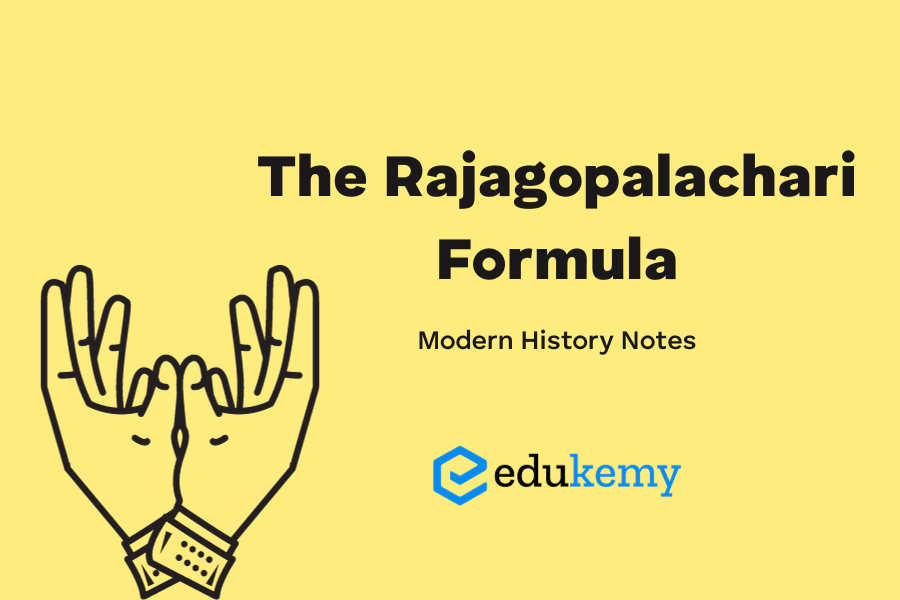
- The Rajagopalachari Formula, also known as the C. R. Formula or Rajaji Formula, was a proposal put forward by C. Rajagopalachari to address the political deadlock between the All India Muslim League and the Indian National Congress regarding the independence of British India. The League demanded the creation of a separate Muslim nation, while the Congress was opposed to the idea of partition.
Contents
Main Points of the Rajagopalachari Formula:
- Muslim League to endorse Congress’s demand for independence.
- League to cooperate with Congress in forming a provisional government at the center.
- After the end of the Second World War, a plebiscite would be conducted in the Muslim-majority areas in North-West and North-East India to decide whether a separate sovereign state should be formed.
- If the partition was accepted, both parties would reach an agreement on safeguarding defense, commerce, communications, etc.
- The above terms would be operative only if England transferred full powers to India.
Reactions to the Formula:
- The Rajagopalachari Formula was seen as a tacit acceptance of the League’s demand for Pakistan, and Mahatma Gandhi supported the proposal.
- However, Muhammad Ali Jinnah wanted Congress to explicitly accept the two-nation theory, which advocated separate nations for Hindus and Muslims.
- Jinnah disagreed with the idea of the entire population voting in the plebiscite and preferred only the Muslims in the Muslim-majority areas to have a say.
- Hindu leaders, led by Vir Savarkar, condemned the CR plan as well.
Causes of Failure:
- While the formula seemed to support the principle of Pakistan, it aimed to demonstrate that the provinces claimed by Jinnah as part of Pakistan had significant non-Muslim populations.
- Jinnah claimed provinces like Punjab and Bengal as Muslim-majority regions. Conducting a plebiscite risked partitioning these provinces, as the entire population, including non-Muslims, would vote in the plebiscite.
- Jinnah was not in favor of a common center with Congress and was primarily interested in creating a separate Muslim nation. The Rajagopalachari Formula did not align with his vision of Pakistan and, therefore, was rejected by Jinnah.
- In conclusion, the Rajagopalachari Formula was an attempt to find a middle ground between the Congress and the Muslim League regarding the demand for Pakistan. However, Jinnah’s refusal to accept the proposal led to its failure, and the partition of India eventually took place in 1947, resulting in the creation of India and Pakistan as separate nations.
Frequently Asked Questions (FAQs)
Q: What was the Rajagopalachari Formula?
Answer: The Rajagopalachari Formula was a proposal presented by C. Rajagopalachari in 1950 as a compromise to address the demand for linguistic states in India. According to the formula, the existing provinces would be reorganized into autonomous linguistic zones. Each zone would have its own official language for internal administration and education, but Hindi would be the official language for the central government. This was an attempt to balance the linguistic diversity of India with the need for a common language at the national level.
Q: Why was the Rajagopalachari Formula not accepted?
Answer: The Rajagopalachari Formula faced strong opposition from linguistic groups, particularly those advocating for a separate state based on language. The formula’s emphasis on Hindi as the sole official language for the central government, coupled with the autonomous linguistic zones, failed to satisfy the demands of linguistic states. This led to widespread protests and resistance, ultimately resulting in the rejection of the Rajagopalachari Formula. The government later adopted the States Reorganization Act of 1956, which formed states based on linguistic lines.
Q: What was the significance of the Rajagopalachari Formula in India’s political history?
Answer: The Rajagopalachari Formula marked an important phase in India’s political history as it highlighted the challenges associated with linguistic diversity and state reorganization. While the formula itself was not implemented, it contributed to the ongoing discourse and demands for linguistic states. The subsequent adoption of the States Reorganization Act in 1956, which created states based on linguistic lines, reflected the evolving nature of India’s federal structure and the recognition of linguistic identity as a crucial factor in the country’s political landscape.
In case you still have your doubts, contact us on 9811333901.
For UPSC Prelims Resources, Click here
For Daily Updates and Study Material:
Join our Telegram Channel – Edukemy for IAS
- 1. Learn through Videos – here
- 2. Be Exam Ready by Practicing Daily MCQs – here
- 3. Daily Newsletter – Get all your Current Affairs Covered – here
- 4. Mains Answer Writing Practice – here

